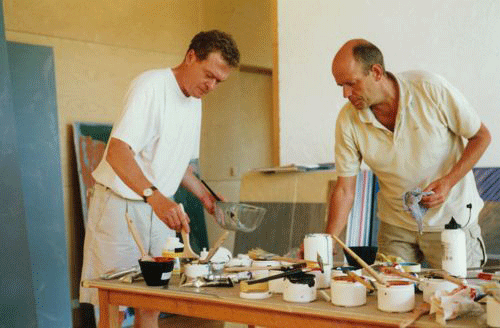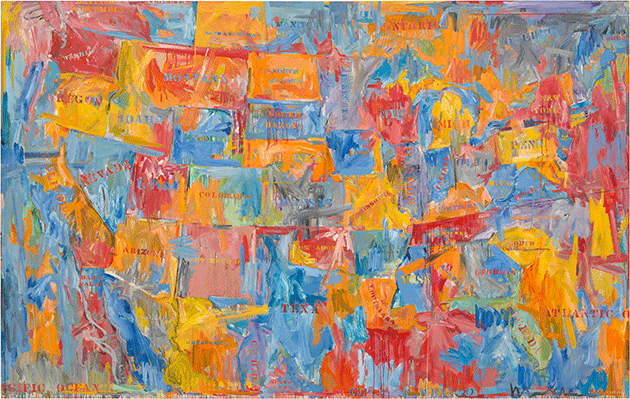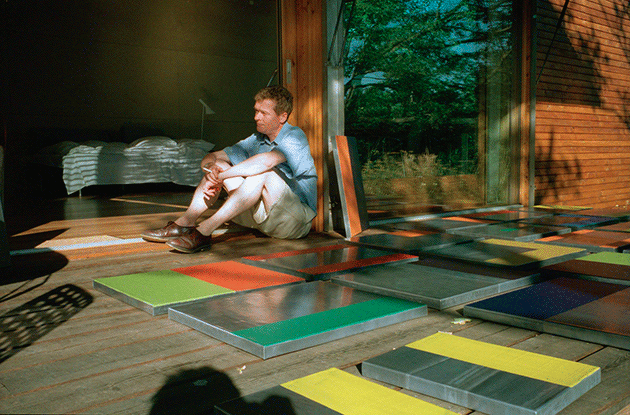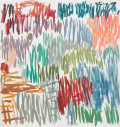https://www.phillips.com/auctions/auction/UK010121

Overview
'The objective is not so much to merely apply a coat of paint but rather to avoid an artistic handwriting in the sense of artistic mannerism.' —Günther FörgIn Untitled, a flurry of colourful strokes motions upwards and downwards on a formidable scale, forming a landscape replete with chromatic lyricism. At once structured and loose, free-flowing and meticulously constructed, the painting belongs to Günther Förg’s celebrated series of Spot Paintings, carried out between 2007 and 2009. The lattice of the grids that Förg had superimposed in his earlier series of Grid and Window Paintings has dissolved in the present work, leaving instead parcels of brushstrokes. With its ‘thoroughly unique’ writing, Untitled is simultaneously abstract and systemic, with areas of colour appearing to delineate a coded system proper to the artist’s own logic. ‘I believe that he goes about the selection of colours in an instinctive and impulsive manner; that is to say, that he relies on his natural dialect’, writes Rudi Fuchs. ‘The colours in Förg’s paintings have stared at me for years, while I remained unable to pinpoint them’.1 Having once resided in the esteemed collection of Mikael Andersen, Untitled is a wonderful testament to Förg’s relationship with the Danish gallerist and collector. Notably, Andersen’s deep commitment to the artists he supported materialised in the physical space of his Studio House, designed by Henning Larsen in Vejby Strand, where painters like Shara Hughes, Eddie Martinez, Tom Anholt and Förg himself resided and worked during the course of several summers.

Günther Förg with Mikael Andersen at Andersen’s Studio House in Vejby, Denmark. Courtesy of Mikael Andersen. Colour, Materiality, and Space
While Förg has clearly resisted categorisation throughout his career, his work has always been thematically consistent, delving into the intricacies of colour, materiality, and space. His initial painterly experiments were occupied with stringent black monochrome works, building upon Kasimir Malevich’s investigation of the black square. Later, he would veer towards an investigation of colour and the physicality of lead in his eponymous Lead Paintings, and subsequently deploy his Window and Grid Paintings, which portended the present work’s gestural hatching forms. His Spot Paintings, exploring these amalgamated notions, are mature formulations of his conceptual and intellectual rigour. They evidence a new modus operandi, whereby Förg’s fascination with pure abstraction becomes more animated and vibrant, and a joy of painting finally takes over. In these works, the white primer remains visible beneath the composition’s surface, shining through the exuberant passages of paint that overlap it. While the coloured scribbles recall Jasper Johns’ gestural hatchings in Map, 1961, Förg’s manipulation of light is redolent of many of Paul Klee’s paintings which seem to produce a comparable luminescence. Describing this lifelong dedication to the theme of colour, Lloyd Wise wrote that Förg’s was a career ‘unencumbered by the twin deadweights of irony and melancholy and filled with a serious and sustained (though never fully credulous) commitment to the twentieth century’s endlessly generative legacy’.2 Capturing the endless possibilities of mingling shades, Untitled bears witness to this varied experimentation.

Jasper Johns, Map, 1961, oil on canvas, The Museum of Modern Art, New York. Image: Scala, Florence. © Jasper Johns/VAGA at ARS, NY and DACS, London 2021 Painting the Sublime
'Günther Förg is not an abstract painter; he is a romantic expressionist, the language of forms laconically borrowed, the colours singing ponderously, like a bronze church bell.' —Rudi FuchsWhile many of his contemporaries, especially in Germany—not least his friend Martin Kippenberger—would create wry, ironic and often anarchic assaults of the art of the past, Förg’s relationship was less critical. ‘Retrospectively, the reason for the continued importance of Förg’s oeuvre becomes clear,’ Andreas Schlaegel would explain in 2011, only a few years after Untitled was painted. ‘The evolution of his direct, subjective engagement with the aesthetic of the sublime — conducted without fear of stereotypical taboos — oscillates between appropriation and homage, yet Förg does so without any ironic quotations or other such cheap distancing techniques. Instead, he throws mythical ballast overboard and appropriates picture-making strategies in a way that makes them look new’.3 With a seemingly visceral tactility, Untitled conveys a novel form of materiality, at once composed and restless, layered like an architectural drawing and unknowably weightless. As such, it lives as a testament to Albert Oehlen’s belief that Förg ‘creates sublime works from something that is already sublime’.4

Günther Förg with his Lead Paintings at Mikael Andersen’s Studio House in Vejby, Denmark. Courtesy of Mikael Andersen. Mikael Andersen in Conversation with Kirsten MacDonald, Regional Director, Scandinavia
Kirsten MacDonald: What makes you feel particularly drawn to Förg's Spot Paintings?
Mikael Andersen: When I turned 50, I held a big vernissage at my gallery which had a number of Förg’s paintings on display. When the works arrived, it was as if spring had come inside the space, filling it with colourful paint. In my view, Förg’s Spot Paintings have looked at the entire history of art — from Philip Guston to Munch and Rothko — and transformed it into a singular expression, undoubtedly his own.
KM: You have a beautiful space in Denmark — Studio House, designed by Henning Larsen in Vejby Strand— which in the summer hosts artists to work in residence. When did you open Studio House and how did that project come about?
MA: The studio is like my child. My husband and I do not have children, so we decided to build this project. We bought the plot next to our holiday home, and when I worked with Förg on the Nordea project in 1998, I was also collaborating with the architect Henning Larsen. I was very inspired by his work and asked him to design the studio. Förg and Henning Larsen were also inspired by each other as Förg's early photographs resonated deeply with the structure and geometry of architecture.
KM: How did Günther Förg come to work at Studio House? At what time was he there, and which series was he working on?
MA: Förg’s first time at Studio House was in 2000. At the time, he was working on his Lead Paintings. ‘I’m an alchemist: I make gold out of lead’, he would say!
KM: Which other artists worked at Studio House?
MA: Shara Hughes, Eddie Martinez, Tom Anholt, among others.
KM: In the tradition of your Berlin space in Prenzlauer Berg, which accommodated your gallery, your home but also a private residence and studio between 2007 and 2014, Studio House incorporates life and creation, featuring both a home and a space for summer residences. Do you believe that when it comes to art, more so than in other professions, work and life go hand in hand?
MA: Yes, if you are there for the sake of art!
KM: Finally, if you had one thing to say about the present work, Untitled, what would it be?
MA: This work shows the dawn of Förg's Spot Paintings. His hand is loose, he has turned away from the grid. The sense of colour is outstanding.
1 Rudi Fuchs, Günther Förg, exh. cat., Stedelijk Museum, Amsterdam 1995, p. 45.
2 Lloyd Wise, ‘Günther Förg: A Fragile Beauty’, Artforum, May 2018, online.
3 Andreas Schlaegel, quoted in Bruce Weber, ‘Günther Förg, German Artist who Made Modernism his Theme, Dies at 61’, The New York Times, 18 December 2013, online.
4 Albert Oehlen quoted in Andreas Schlaegl, ‘Günther Förg: Galerie Max Hetzler’, Frieze, Spring 2012, online.Description
View our Conditions of Sale.
Provenance
Galerie Mikael Andersen, Copenhagen
Acquired from the above by the present owner in 2010Exhibited
Copenhagen, Galerie Mikael Andersen, Günther Förg - Works 1998-2017, 13 March - 3 June 2020
PROPERTY FROM AN IMPORTANT PRIVATE SCANDINAVIAN COLLECTION
31
Untitled
signed and dated 'Förg 07' upper right
acrylic on canvas
200.3 x 190.6 cm (78 7/8 x 75 in.)
Painted in 2007, this work is recorded in the archive of Günther Förg as no. WVF.07.B.0008.
We thank Mr Michael Neff from the Estate of Günther Förg for the information he has kindly provided on this work.
Estimate
£380,000 - 450,000 ‡ ♠
Rosanna Widén
Senior Specialist, Head of Evening Sale
+ 44 20 7318 4060
rwiden@phillips.com
Olivia Thornton
Head of 20th Century & Contemporary Art, Europe
+ 44 20 7318 4099
othornton@phillips.com

No comments:
Post a Comment